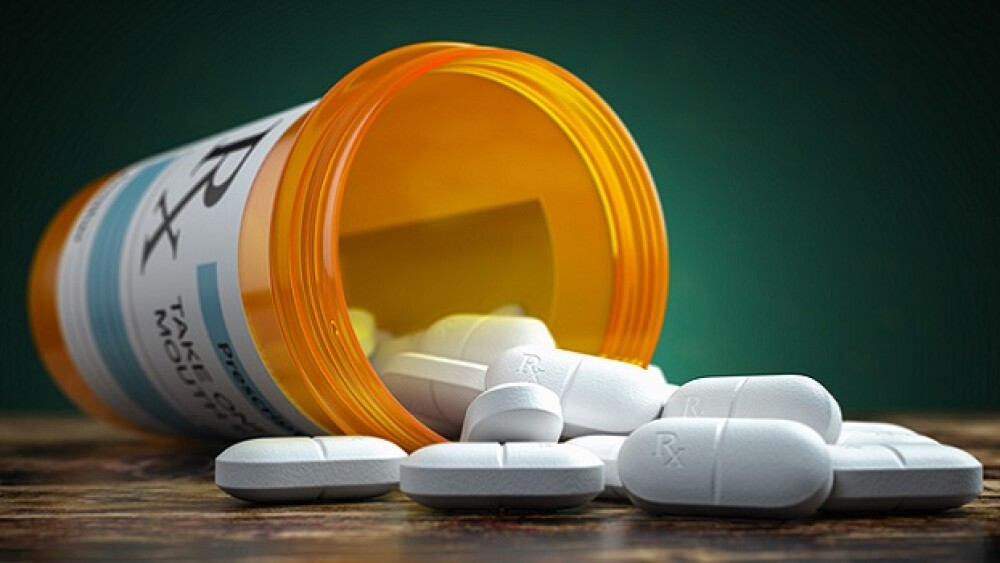The company’s oral gut-targeting polymer, GLY-200, demonstrated promising safety and efficacy in patients with Type 2 diabetes, assessing the candidate as an adjunct treatment to diet and exercise.
Pictured: Pills spilling out from a yellow container/iStock, Bet_Noire
Top-line results from a Phase IIa study showed that Glyscend Therapeutics’ lead candidate GLY-200 demonstrated promising safety and efficacy in patients with Type 2 diabetes, the company announced Wednesday.
Glyscend did not provide specific data to support GLY-200’s efficacy but did reveal that when used as an adjunct to lifestyle adjustments, the candidate induced a statistically significant reduction in postprandial glucose levels compared with standardized meals. Treatment with GLY-200, an oral gut-targeting polymer, also lowered body weight.
Moreover, when study participants were allowed to eat as they pleased, those in the GLY-200 group showed lower overall intake levels and better appetite regulation than the placebo counterparts.
As for safety, Glyscend detected no treatment-related safety concerns, with a pharmacokinetic profile consistent with other non-absorbed, gut-restricted, polymer-based medicines.
These data appear to validate GLY-200’s unique mechanism of action and show that “duodenal exclusion may be possible with a non-invasive, orally administered pharmaceutical treatment,” Glyscend CEO Ashish Nimgaonkar said in a statement.
GLY-200 could provide patients and doctors “an additive or alternative option in their diabetes and obesity treatment toolboxes,” Nimgaonkar said, adding that the company is gearing up to push the candidate into Phase IIb.
Designed to be orally available, GLY-200 is a proprietary polymer with first-in-class potential. It works by binding and forming complexes with a type of large glycoprotein called mucin, which boosts the natural mucus barrier in the upper part of the small intestine.
This mechanism of action allows GLY-200 to non-invasively and pharmacologically reproduce some of the benefits of bariatric surgery, such as improved glycemic and body weight regulation.
Glyscend’s Phase IIa trial evaluated the safety and efficacy of GLY2-200’s mechanism in 51 patients with Type 2 diabetes, assessing the candidate as an adjunct treatment to diet and exercise. Patients were given either the investigational polymer or placebo twice a day for 14 days and were followed up for a week after.
These Phase IIa data confirm GLY-200’s Phase I pharmacodynamic performance, demonstrating significant benefits on glucose, insulin and bile acid levels, as well as on gut hormones such as glicentin, PYY and GLP-1. These changes mirror common biomarker alterations following metabolic surgery, which could indicate therapeutic effects in the small intestine.
Glyscend will present these Phase I data and pre-clinical results at the upcoming American Diabetes Association 83rd Scientific Sessions.
GLY-200’s first-in-class potential could also put Glyscend in the same arena as Eli Lilly and Novo Nordisk, two of the industry’s heaviest hitters in the weight-loss space.
Lilly owns Mounjaro (tirzepatide), which acts on GLP-1 and GIP hormones. In April 2023, the drug met its primary and secondary endpoints in the Phase III SURMOUNT-2 study, inducing significantly better weight loss than the placebo.
These findings position Mounjaro as a prime challenger to Novo Nordisk’s Wegovy (semaglutide). The same month, Lilly posted another Phase III study, dubbed SURMOUNT-5, that will directly compare Mounjaro against Wegovy in obese or overweight participants without Type 2 diabetes. The study is still currently recruiting participants.
Tristan Manalac is an independent science writer based in metro Manila, Philippines. He can be reached at tristan@tristanmanalac.com or tristan.manalac@biospace.com.






